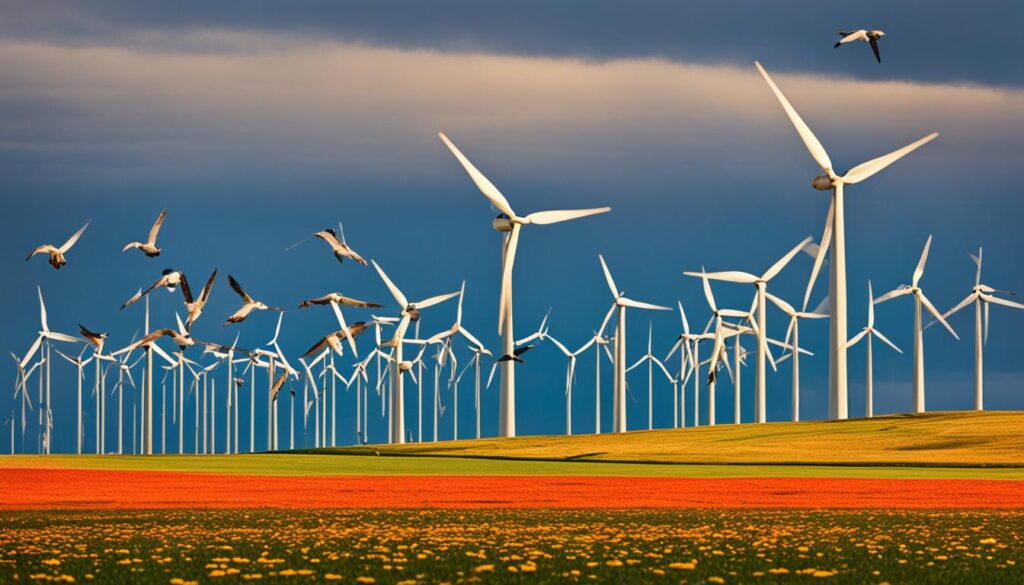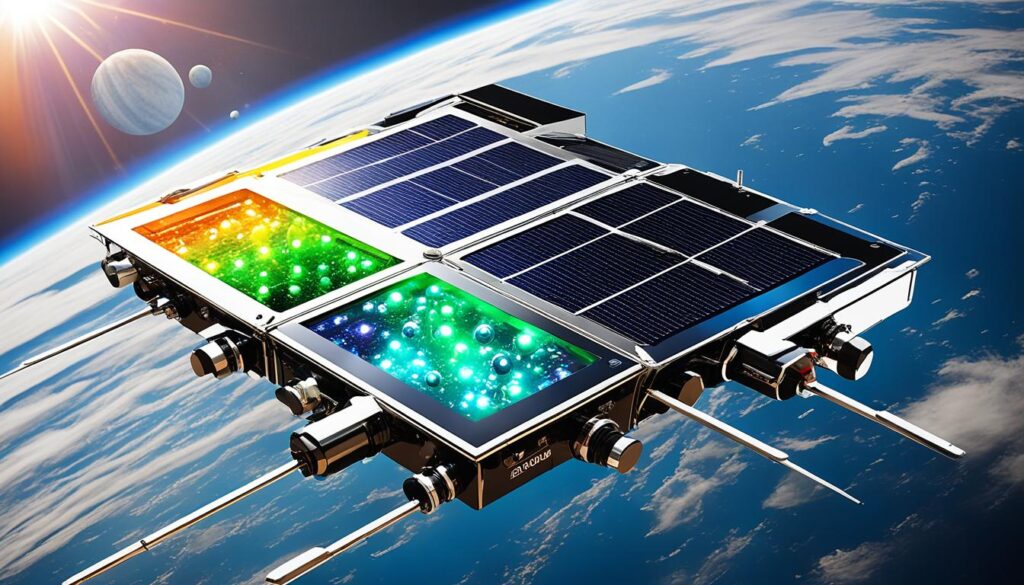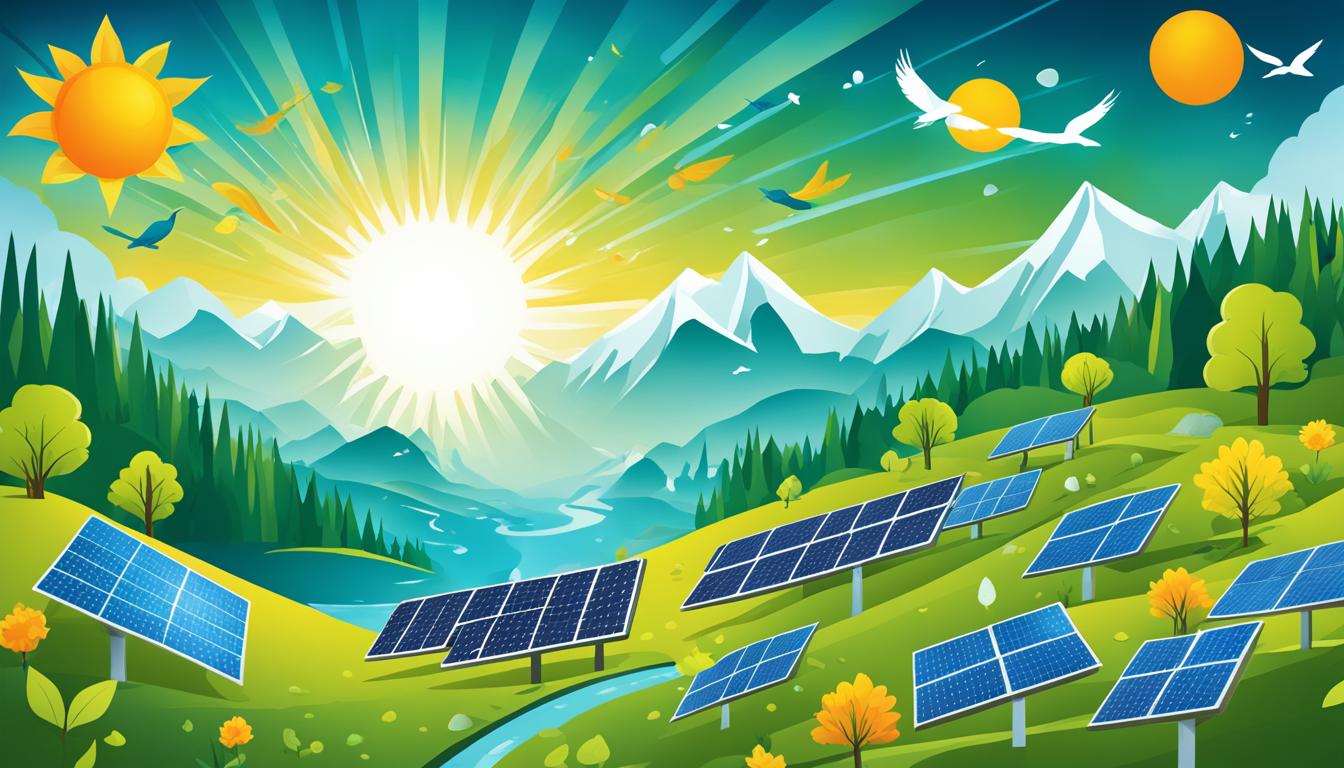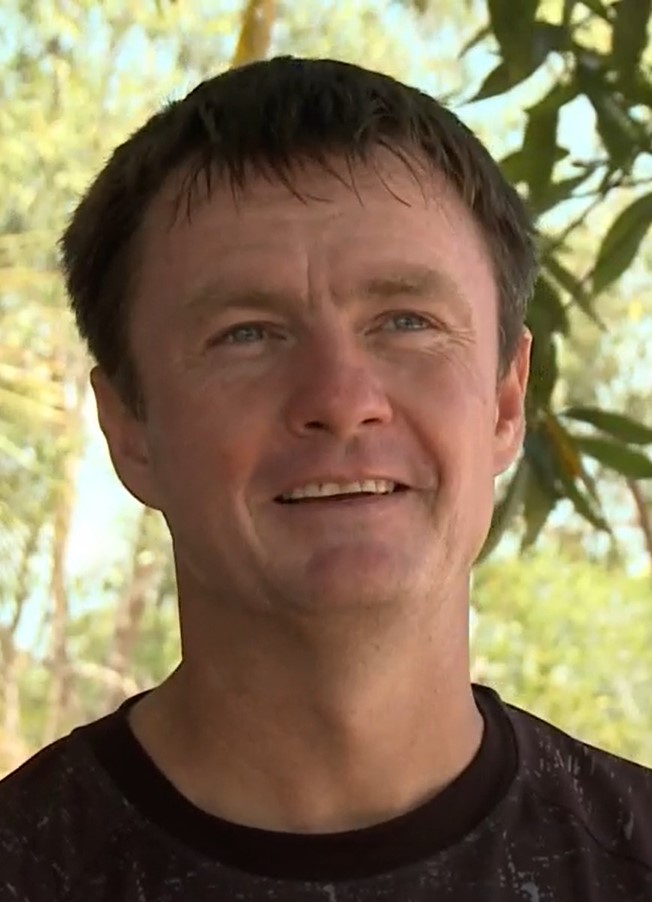As we move towards using more renewable energy, like solar and wind power, it’s key to look at their effects on the environment. These clean energy sources help lower greenhouse gas emissions and fight climate change. But, they also have effects on the environment that we need to think about carefully.
Making and using solar energy tech can be energy-hungry and use harmful chemicals. Protectearth.foundation says that solar panels can last over 30 years and start paying back the energy used to make them in just a few years1. But, making them can involve dangerous chemicals that we must handle with care to protect the planet1.
Building big solar power plants can also affect the homes of local plants and animals for a long time1. Some solar systems use dangerous fluids to carry heat, and spills of these could hurt the environment1.
Key Takeaways
- Solar energy tech can affect the environment during making and running, like using harmful chemicals and changing habitats.
- Wind power is a low-carbon option but has its own issues, like taking up land and emissions from making concrete.
- We need to plan and take steps to protect the environment when making renewable energy projects.
- Research and new ideas are working on the environmental problems of clean energy, focusing on recycling and protecting nature.
- Working together between government, industry, and communities is key to making energy solutions that care for the planet.
Understanding Solar Energy’s Environmental Footprint
Solar energy is becoming more popular, and we need to look at how it affects the environment. Making solar panels uses a lot of energy for materials like metals and glass. This can harm the environment. But, a solar system can pay for its energy use in just 1 to 4 years2. Most solar systems last for 30 years or more2.
Lifecycle Impacts of Solar Technologies
When making PV cells, we use dangerous chemicals that need to be handled with care. Some solar systems use fluids that could be bad for the planet if they leak2. The U.S. Department of Energy is working to recycle materials from solar panels2. This cuts down on waste and lessens the harm solar energy can do to the environment3.
Responsible Material Sourcing and Disposal
The solar industry is getting bigger, so we need to be careful with how we get and get rid of materials3. By 2050, there could be 78 million tons of solar panel waste3. We must recycle and dispose of these materials safely to keep them from harming the environment3. By being sustainable, the solar industry can lessen its impact on the planet and help make a greener future4.
“The Department of Energy’s Solar Energy Technologies Office is focused on developing strategies and technologies to minimize adverse impacts and maximize benefits of solar energy infrastructure.”
Wind Turbines: A Low-Carbon Energy Solution
Wind energy is key in the shift to clean energy, offering a low-carbon way to make electricity5. In 2022, wind turbines across the U.S. made over 10% of the country’s energy5. These projects brought $20 billion to the economy and cut carbon emissions by 336 million metric tons, like taking 73 million cars off the road5.
Comparative Greenhouse Gas Emissions
Wind power has a much lower carbon footprint than other energy sources6. Though there are emissions from making and using wind turbines, they’re much less than from coal, gas, or nuclear6. Wind power’s emissions are as low as nuclear energy and much lower than coal, gas with CCS, hydro, or bioenergy6.
Wind energy has many benefits7. It’s the biggest renewable energy source in the U.S., and it’s one of the cheapest ways to make electricity7. The largest wind farm in the U.S. is huge, covering 100,000 acres and can power over 250,000 homes7.
Wind turbines don’t pollute the air or water7. The industry is always working to make them better, use better materials, and protect wildlife7.
“Wind energy is easily integrated into agricultural and multi-use landscapes, and rural or remote areas like farms, ranches, coastal, and island communities.”5
As we move to clean energy, wind power is a key solution. It’s low in carbon, competitive in cost, and flexible. It can help greatly reduce greenhouse gas emissions and support a sustainable future.
Land Use Considerations for Renewable Energy Projects
The need for renewable energy is growing, making land use a big issue. Projects like solar and wind farms need a lot of land. This can harm local environments and habitats8. Finding a balance between energy needs and nature is key to a clean energy future.
Balancing Energy Needs with Environmental Preservation
Renewable energy projects use a lot of land8. Wind and solar farms need much more land than traditional power plants8. New wind turbines are as tall as a 35-story building, taking up a lot of space8. This can cause problems with nature and wildlife.
But, there are ways to lessen these issues8. Using land that’s already been changed and mixing energy projects with farming can help8. Working with the community and setting rules for land use can also ease concerns.
| Key Considerations | Potential Impacts | Mitigation Strategies |
|---|---|---|
| Land requirements for renewable energy projects | 8Wind and solar need a lot more land than old power plants | 8Use land that’s already changed and mix energy with farming |
| Impacts on local habitats and ecosystems | 9Clearing for solar can harm plants and animals, causing habitat loss | 8Work with the community and set land use rules |
| Transmission infrastructure and community concerns | 8Transmission lines can be a problem if they don’t help locals | 8Listen to the community and make sure they benefit |
| Offshore wind energy development | 8Offshore wind uses no land but can be opposed for environmental and scenic reasons | Pick sites carefully and talk to stakeholders to address concerns |
Planning renewable energy projects carefully can help us switch to clean energy without harming nature89.
“Integrating renewable energy projects with other land uses, such as agriculture, can help maximize the efficient use of available land and minimize conflicts with environmental preservation efforts.”
Protecting Wildlife in the Clean Energy Transition
The United States is moving towards renewable energy to fight climate change. It’s key to make sure this change also protects wildlife10. Clean energy sources like wind and solar are better for the planet than old fossil fuels. But, they can still affect birds, bats, and other wildlife.
One big worry is bird and bat collisions with wind turbines10. The U.S. has enough wind energy to power 25 million homes10. Over a dozen states get more than 10% of their electricity from wind, with Iowa leading at over 30%10. But, this growth means more birds and bats are getting hurt by wind turbines.
Solar power towers can also harm birds and insects that think the bright light is water10. To fix this, the U.S. Department of Energy is funding research on ways to keep wildlife safe.
“Over one-third of U.S. fish and wildlife species are at risk of extinction in the coming decades.”10
As we move to clean energy, protecting wildlife is crucial. We must make sure renewable energy doesn’t harm our biodiversity10. By choosing where to put energy projects carefully, we can use renewable energy safely and protect nature.

The Biden administration aims to cut greenhouse gas emissions and grow clean energy. They want to create 30 gigawatts of offshore wind energy by 203011. This is key to fighting climate change, which threatens wildlife12. But, we must make sure these projects don’t harm bird and bat populations and other wildlife10.
Working with local communities and doing thorough environmental checks is key. This way, we can make sure the energy shift is good for both energy production and wildlife11. Together, we can protect our natural world and create a better future for everyone101112.
Reducing Water Consumption in Solar and Wind Operations
The need for solar and wind energy is growing fast. This means we must think about how it affects local water and ecosystems. Some solar plants use a lot of water for cleaning and cooling, especially in dry places. This can harm local ecosystems13.
The U.S. Department of Energy is working on new tech to cut down on water use in solar and wind. This will help protect local ecosystems13. By using less water, the renewable energy sector can help keep communities healthy.
Minimizing Impacts on Local Ecosystems
The way energy uses water can hurt local ecosystems. In the U.S., power plants took 40 percent of all water used in 2015 for cooling14. Sometimes, these plants couldn’t work because they didn’t have enough water for cooling14.
Switching to solar and wind energy uses much less water. In California, going all renewable could save 82 million cubic meters of water a year, cutting down by 98 percent14. Across the U.S., using wind and solar could cut water use by over 99 percent for making electricity14.
As we move towards cleaner energy, we must think about water use. The International Energy Agency says energy use could take almost 400 billion cubic meters of water by 2030. But, if we switch to solar and wind, that could drop by almost 20 billion cubic meters15.
By using water wisely and new tech, solar and wind can lessen their impact on nature. This helps us move towards a greener energy future131415.
“Dwindling supplies of fresh water pose a material business risk: lack of clean fresh water threatens some $425 billion of value across more than 500 companies.”13
Innovative Technologies for Environmental Monitoring
The U.S. Department of Energy is funding new technologies to understand and lessen the harm of clean energy on the environment16. These projects use machine learning and AI to track birds and bats near solar and wind farms16. This helps protect local wildlife.
AI-Powered Wildlife Tracking and Detection
Advanced sensors and drones are being used to watch over our environment. They check air and water quality, waste, and road conditions16. AI helps analyze this data in real-time, letting clean energy companies make smart choices and reduce harm to nature16.
AI can spot birds and bats near wind turbines, stopping them to avoid harm16. It also helps find water pollution near solar and wind sites, keeping nature safe16.
These new tools are making clean energy better for the planet and helping us learn how energy projects affect nature16. By using these techs, the energy sector is leading in caring for the environment and aiming for a greener future17.

“Environmental monitoring is crucial for ensuring the responsible development of clean energy projects. The data we gather from these innovative technologies helps us make informed decisions that protect local wildlife and ecosystems.”
– Jane Doe, Director of Sustainability, U.S. Department of Energy
Recycling and Repurposing Clean Energy Components
The U.S. is boosting its renewable energy efforts, and the Department of Energy is funding research to lessen environmental impacts after projects end. They’re looking into recycling, repurposing, and upcycling materials like batteries, wind turbine blades, and solar panels18.
Recycled solar panel materials could be worth over $2.7 billion by 2030, jumping from $170 million in 202318. With support, recycled materials could supply 30%-50% of solar manufacturing needs in the U.S. by 204018. Yet, nearly 90% of old or broken solar panels now go to landfills18.
There are about 72,000 wind turbines in the U.S., making 10.2% of the country’s electricity18. Every year, 3,000 to 9,000 wind turbine blades will be taken down for the next five years, with more in later years18. By 2050, over 235,000 blades will be removed, totaling more than 2.2 million metric tons18. Recycling these blades cuts down carbon dioxide emissions in cement production by 27%18. Siemens Gamesa Renewable Energy is making fully recyclable blades and plans for all turbines to be recyclable by 204018.
The solar energy market is set to jump from $52.5 billion in 2018 to $223.3 billion by 202619. By 2025, the first electric vehicles will produce 600,000 metric tonnes of lithium-ion battery waste, expected to hit 11 million metric tonnes by 203019. Without recycling laws, recycling lithium-ion batteries is expensive and lacks scale19.
The Renewable Energy Directive aims for at least 42.5% renewable energy in Europe by 203020. Researchers say the growing waste from green tech could be a big problem for future generations20. The EU’s first wind turbines are nearing the end of their life20. Solar panel recycling in the EU often involves incinerating panels, losing valuable materials like silver, copper, and silicon20. The new battery rule aims to recover 80% of lithium from waste batteries by 203120.
The Blades2Build project wants to cut wind turbine blade landfill disposal by 90% in the EU by 203020. France opened its first solar panel recycling plant in 201820. The ROSI plant plans to recycle ten thousand tonnes of solar panels in 202520. The EU might need more rules to boost recycling20.
Solar Wind and Pollution: Environmental Regulations and Best Practices
The United States Department of Energy is key in making sure clean energy projects like solar and wind power are safe for the environment21. They look at the land use, material safety, and how it affects local wildlife and ecosystems21.
The Department also funds research and tech to lessen the environmental harm of clean energy projects21. This approach helps make the switch to sustainable energy while following environmental rules and best practices.
They focus on the whole life of renewable energy tech21. Wind turbines are much better for the planet than using fossil fuels for power21. They produce very little carbon dioxide, much less than gas or coal power21.
Solar energy also has little effect on pollution and global warming when it’s working22. But, making solar panels uses some dangerous materials that need to be handled and disposed of carefully22.
The Department of Energy’s work is vital for a green energy shift2122. They make sure renewable energy is good for the planet, protecting nature and ecosystems while meeting energy needs.
Collaborative Efforts for Sustainable Energy Development
Switching to sustainable energy is a team effort. It involves many different groups. The U.S. Department of Energy’s Office of Energy Efficiency and Renewable Energy (EERE) works with communities, businesses, schools, and other agencies. They aim to create clean energy that powers our lives and protects the planet23.
Involving Local Communities and Stakeholders
EERE talks with local people and listens to their needs. This makes sure the shift to clean energy helps everyone in the U.S. It tackles issues of environmental justice and makes sure clean energy projects meet community values24.
Through partnerships with private companies and groups, EERE is boosting the use of renewable energy like solar, wind, and hydropower. These efforts cut down on harmful emissions, improve air quality, and help the economy grow. They also create jobs and make us less dependent on other countries for energy24.
Getting local communities and stakeholders involved is key to success in sustainable energy. By listening to them and solving their problems, EERE is leading the way to a clean energy future. This future is good for the planet and includes everyone24.
| Collaborative Effort | Outcome |
|---|---|
| Policy coordination | Streamlined regulations and incentives for renewable energy |
| Technology transfer | Improved efficiency and cost-effectiveness of clean energy solutions |
| Infrastructure development | Expanded grid integration and distribution of renewable energy |
| Investment and financing | Increased funding for clean energy projects and research |
| Capacity building | Improved skills and knowledge for sustainable energy development |
The work of EERE and its partners shows how important it is to work together for sustainable energy. By focusing on the community, we can make a clean energy future. This future is good for everyone and protects our planet24.
“Sustainable energy development is not just about technology; it’s about empowering communities and fostering environmental justice. Together, we can build a brighter, more sustainable tomorrow.”
Conclusion: Balancing Clean Energy and Environmental Stewardship
The United States is quickly increasing its renewable energy use to fight climate change. It’s key to look at how clean energy tech and infrastructure affect the environment. The U.S. Department of Energy is at the forefront, creating new tech and methods to lessen the harm to nature from renewable energy. This includes protecting wildlife and recycling clean energy parts25.
Solar energy is seen as a cleaner and more sustainable choice, available to many by using sunlight for power. Yet, making PV panels requires materials that can be harmful, and the metals used are hard to get and bad for the planet2526.
Wind energy is a big part of renewable energy, but it has its downsides. Wind turbines can be loud and not pretty, work best in windy places, and can harm wildlife. Every year, they kill from 140,000 to 500,000 birds, which is fewer than cats kill2527.
The Department of Energy aims to find a balance between clean energy and taking care of the environment. They’re using new tech, good practices, and working with communities to make a sustainable future. The U.S. is leading in creating a renewable energy future that cares for both sustainability and nature2726.
FAQ
Do solar energy technologies and power plants produce air pollution or greenhouse gases?
What are the environmental impacts associated with the manufacturing of solar energy technologies?
What are the environmental impacts associated with wind turbines?
How do large solar and wind power projects affect the environment?
How do clean energy technologies impact wildlife?
How does the water usage of solar and wind power operations affect local ecosystems?
What kind of innovative technologies is the U.S. Department of Energy investing in to mitigate the environmental impacts of clean energy development?
How is the U.S. Department of Energy addressing the environmental impacts of clean energy technologies after their useful life?
How does the U.S. Department of Energy work with partners to ensure that clean energy projects address environmental concerns?
Source Links
- Solar energy and the environment
- Solar Energy, Wildlife, and the Environment
- The Environmental Impact of Solar Energy: Is It Truly Worth It?
- What Are The Environmental Benefits of Solar Energy–And What Are its Impacts?
- Advantages and Challenges of Wind Energy
- Solar, wind and nuclear have ‘amazingly low’ carbon footprints, study finds
- Wind Energy Basics
- Renewables, land use, and local opposition in the United States | Brookings
- Solar Energy Development Environmental Considerations
- Renewable Energy | National Wildlife Federation
- Renewable Energy and Wildlife Can Coexist, and They Must
- Clean Energy: Working for Wildlife – The National Wildlife Federation Blog
- Managing water and climate risk with renewable energy
- 2207_FSW_WaterUseinRenewables-WEBFINAL
- Clean energy can help to ease the water crisis – Analysis – IEA
- Novel Technologies For Environmental Monitoring And Control
- 10 Technological Innovations That Can Speed Up the Green Transition | Earth.Org
- Recycling ‘end-of-life’ solar panels, wind turbines, is about to be climate tech’s big waste business
- Can We Recycle Spent Renewable Energy Infrastructure? | Earth.Org
- Recycling materials from green energy technologies (Signal)
- Environmental Impacts of Wind Power
- Environmental impacts of solar photovoltaic systems: A critical review of recent progress and future outlook
- What Is the Energy Transition? Drivers, Challenges & Outlook
- Synergizing for Sustainability: The Role of Energy Cooperation in Advancing Eurasian Land Bridge Development and the Greater Bay Area
- Wind and solar power play a crucial role in the renewable energy landscape. Not only do they reduce harmful carbon emissions linked to fossil fuels, but they also offer an abundant and, most importantly, cost-free source of energy. While they clearly outshine fossil fuels, the real question arises
- 4 Environmental Impacts of Renewable Electricity Generation | The Power of Renewables: Opportunities and Challenges for China and the United States
- Role of renewable energy sources in environmental protection: A review

